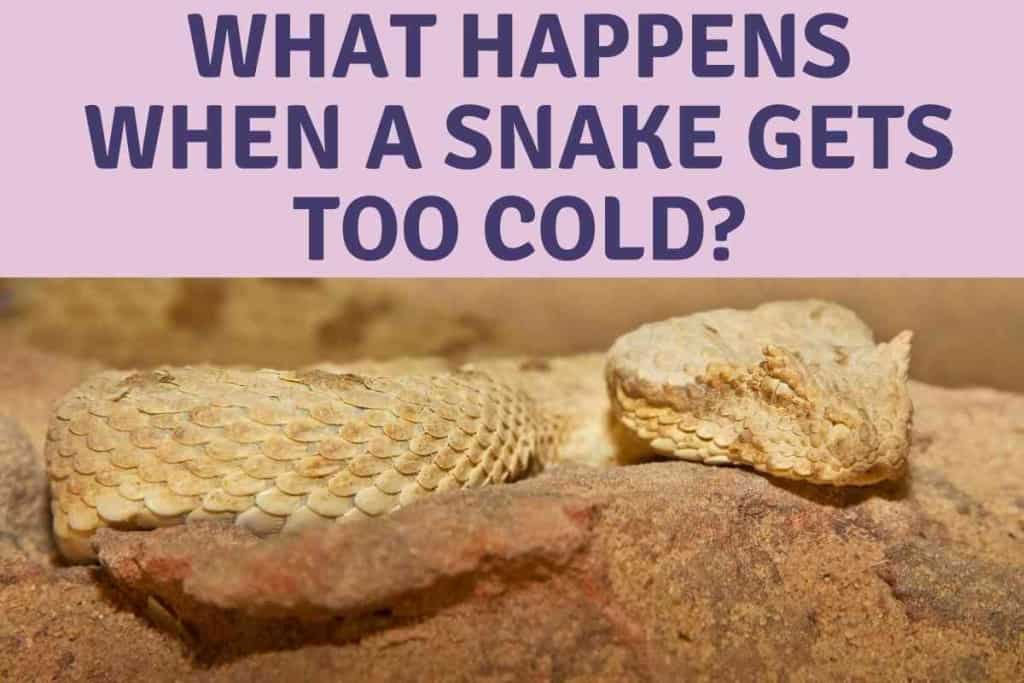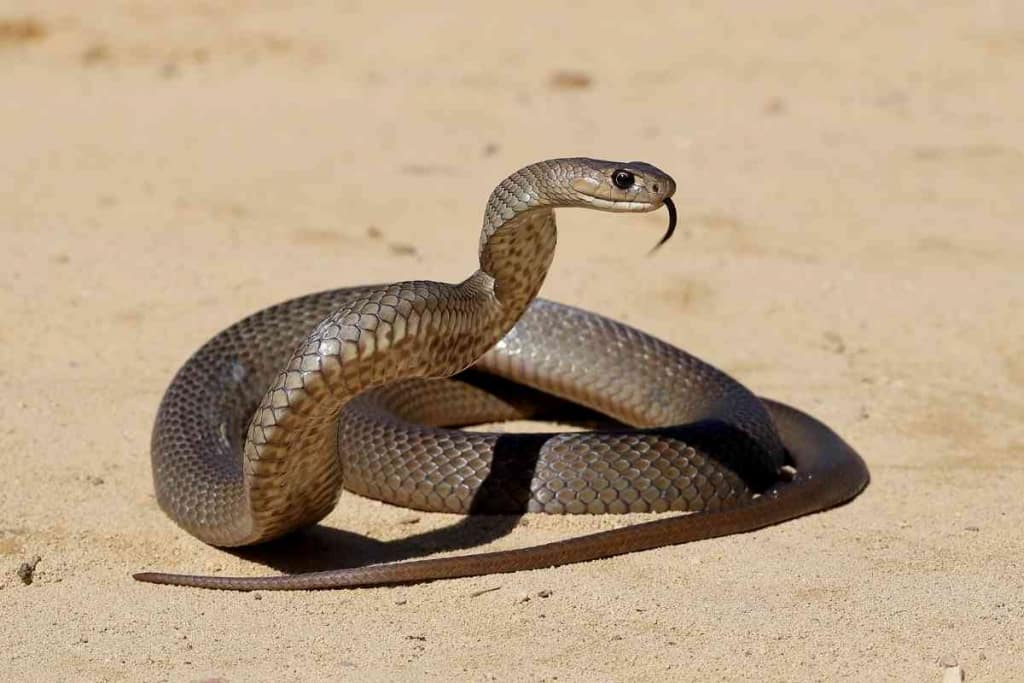What Happens When A Snake Gets Too Cold? 6 Warning Signs!
As with all reptiles, snakes are ectothermic (cold-blooded), meaning they rely on their environment for heat.
The heat could be from the sun or an artificial source such as a lamp. Since snakes cannot generate their body heat, if they cannot identify a warm place, their bodies will acquire the temperature of the surrounding environment. If the surrounding temperature is too cold, the snake will absorb it, which is detrimental to their health.

What Happens When A Snake Gets Too Cold?
When a snake gets too cold, it may get side effects such as hypothermia, regurgitating or vomiting, stopping eating, or becoming dormant. Worst case scenario, the snake may die. However, all of these can be avoided if the snakes get adequate temperature.
What might occur if a snake becomes too cold? Can a snake heal itself after being too cold? How can you ensure a snake is constantly warm or give them a heat source in an emergency?
We utilized knowledge from snake logs and articles and first-hand information from snake breeders to develop the most comprehensive content.
Why Do Snakes Require Heat?
In contrast to warm-blooded humans, snakes cannot regulate their temperature. Their bodies must absorb heat to perform their bodily functions, including moving, digestion, and reproduction.
Serpents in the wild often inhabit only constant warm regions. It’s their primary heat source, but they also require a basking area to warm up further. Snakes bask on rocks or branches to absorb sunlight and maintain their health.
When a snake is kept as a pet indoors, the owner is accountable for supplying a heat source because there is no access to natural sunlight. A constant temperature must be maintained in the snake’s tank, necessitating a heater.
You must also provide a basking area for the snake to raise their body temperature when necessary to perform digestion and energy production processes.
Remember that a snake will not always bask. The snake also requires time to cool off its body temperature as well.
Bear in mind, however, that the basking spot must be accessible at all times so they can adjust their body temperature as necessary.
What is the Optimal Tank Temperature For A Snake?
Varying snake species require different temperatures to survive and thrive. Snakes can survive a lot of things, but some of them have very particular temperature requirements.
The aquarium should be partitioned into several parts, depending on the temperature. The cooler portion of the snake’s aquarium must be at least 75 degrees Fahrenheit for them to survive.
However, the best general tank temperature is approximately 80°F, with a basking spot temperature of approximately 90°F.
The snake can get burnt if the temperature in the tank, especially in the basking area, is excessive. If the snake does not have a place to cool off, any temperature exceeding 95 degrees Fahrenheit is too warm.
How Long Can Snakes Live Without Heat?
Snakes can survive 75°F temperatures for approximately six hours before their bodies start to shut. Any temperature below 75°F diminishes your snake’s ability to live without heat, and temps under 65°F for even a few hours can be lethal.
Consider the fact that snakes do not brumate. If your snake appears to be brumating, the temperature is likely too low.

What Transpires If A Snake Gets Very Cold?
When a serpent becomes too cold, it may suffer a range of health issues or slow down its metabolism. A few problems that could develop if a snake becomes too cold are:
Colds
As with humans, snakes can catch a cold. However, the difference is snakes utilize heat to combat the cold. Furthermore, heat is essential in assisting in the digestion of the snake’s food, which gives them energy.
Hypothermia
Snakes can develop hypothermia if kept in a too-cold surrounding for too long or if it only receives heat for a short time. Hypothermia can also lead to other health issues for your snake, including respiratory illnesses.
Hypothermia is characterized by dehydrated skin, slowed movement, and appetite loss.
Death
If the serpent is exposed to cold temperatures for too long, it will die of hypothermia due to various problems caused by the cold weather.
Since its organs will become inoperable, for example, the kidney and liver of the snake that filters blood that contains waste and toxins and the lungs that take up oxygen and air will cease to work.
These functions are paramount to the snake’s survival, and if they can’t be met, the snake may die.
Snakes are understandably extremely susceptible when they are sick and sluggish. In a compromised state, the snake will be unable to move quickly or protect itself effectively if a predator detects it.
Regurgitate or Vomiting
Since serpents are ectothermic, their gut systems differ from mammalian digestive systems. The microbes in a snake’s digestive tract cannot break down food. When a snake’s stomach is too chilly, it cannot digest food.
The meal will begin to decompose and necessitate the snake to dispose of it as soon as possible, or else It will regurgitate or vomit. It’s possible that your snake can choke when this happens.
There is a distinction between regurgitation and vomiting. Regurgitation happens when a snake throws up recently ingested food that will be whole and unprocessed that is produced in the throat.
Vomiting is the snake throwing up food that may have been thoroughly or partially digested.
Snake Stops Eating
A snake will cease eating reflexively when the temperature decreases. Since when the snake consumes anything, it vomits it up. Consequently, the snake realizes that hunting and eating would waste energy and resources.
However, once the temperature rises, your snake will resume feeding. It may also eat before sunbathing if it has access to a suitable location.
Resist the urge to hold your snake after it eats as this can also cause them to vomit.
The Snake Goes Dormant
If the snake has no place to warm itself, it will quickly become lethargic. It may cease moving for a long time under certain conditions. And once it begins to move, it will do so at a glacial rate.
This habit is often mistaken for hibernation, but snakes do not hibernate, just mammals do. This habit is referred to as brumation and comprises a decrease in body temperature, heart and breathing rate.
It’s comparable to taking an extended break. In this respect, it resembles hibernation but without slowing the heart rate and breathing rate.
The temperature at which snakes brumate is roughly 60 degrees; however, breeders recommend a temperature of 55 degrees.
The snake needs a hibernaculum or hibernating place to bromate and remains immobile until the heat increases again.
During the warmest portion of the day, it may roam around in search of a sunny area. Other than that, it will remain entirely inert.
What Should Be Done If the Heat Is Off?
Everyone has suffered a power outage at some point in their life. It may not be a pleasant experience, and the longer the power is out, the more anxious the snake will become.
Sometimes, the tank’s heat source fails, and you cannot go to the shop promptly to replace it.
There are a few things to do to keep the snake warm and prevent them from being too cold if the temperature in its tank drops to a harmful level.
Place Hot Water Bottles In The Tank
If you have access to hot water, fill several water bottles and place them in the snake’s tank to help it warm up.
Generate A Gradient
Consistently provide the serpent with a thermal gradient or a variation of temperatures. The temperature difference gives the snake the option to warm up or cool down accordingly. You can achieve this by placing heating equipment at one end of the tank, establishing a warm and cold side.
Despite species-specific differences, the vast majority of snakes follow a daily routine of basking and chilling.
Radiant Heating Panels
Heat panels provide several advantages over other heating techniques since they do not emit visible light. However, some snake species may perceive the heat emanating from the panel just as they would any other warm object in their environment.
Because each parameter can be modified independently, decoupling the lighting and heating elements of the snake provides you more control over their environment.
While a thermostat cannot be used with the serpent’s lights, it can and should be used with the radiant heat panel.
Lastly, unlike hot rocks and light bulbs, radiant heat panels do not reach temperatures high enough to harm your reptile.
Keep An Eye On the Temperature
Adding on to radiant heat panels, snake keepers need a thermostat and a digital thermometer to create the optimal environment for their reptiles. Since ta fluctuates throughout the day, your snake’s tank may get too hot or too cold without a method to adjust heat output to account for these fluctuations.
Since thermostats regulate the amount of heat produced by the panel, the tank can maintain constant temperatures regardless of fluctuations in the external temperature.
Because the thermostat may glitch or be poorly calibrated, invest in a digital thermometer that enables you to confirm that the temperature in your snake’s tank is accurate.
Most keepers choose non-contact infrared thermometers. Air temperatures, which can be measured with a standard digital thermometer, must be distinguished from surface temperatures recorded with a non-contact thermometer.
